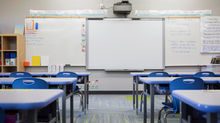Document Cameras
- Breanna Dixon
- Oct 5, 2017
- 3 min read
I'm sure by now, most of us have at least seen a document camera in use. But did you know the different ways document cameras can help to transform how we teach? Teachers can use the document camera to display worksheets, books, pictures, maps, three dimensional objects, and even videos all using their document camera and only their document camera. Joe Frisk marvels that for document cameras, "[t]he learning curve with this technology is short, often measured in minutes" (par 2). It is not difficult for teachers to learn to use or to use in their classrooms. While Frisk acknowledges the expense of the document camera, he also commends its many positive features such as giving students an opportunity for interactive learning that they would not have experienced prior when compared to Power Points or transparency-projectors.
Document cameras also help to give new life to the old, tried and true classroom activities such as worksheets or reading a text to students. With the document camera, teachers can now work together on worksheets with students using the live image function or have students come up to the document camera and write in their answers for that worksheet. Teachers can also use the live image function to display the text as they read together and model their annotations/notes.
But what about students? How can document cameras be also used as a way for interactive activity? We know from previous blogs that teachers often use technology as a way to support their teaching and curriculum but don't use it as often to support student interaction with the technology. So far I've only talked about the wonderful ways document cameras are useful for teachers, but they can also be used for student projects, presentations, and for modeling. AVer shares example lesson plans in language arts, math, writing, social studies, science, art & music, and others that allows teachers to easily being incorporating the use of a document camera in their classroom. One lesson, for example, encourages teachers to let students first a read a book, and then share using the document camera examples of idioms, foreshadowing, nouns, etc. with the class (http://www.averusa.com/classroom-technology/uploads/FinalAVerMedia.pdf). This plan allows students to learn how to use the technology while also meeting their learning target or standard. Other ways students could use a document camera is by using the recording feature to possibly create a newscast for a social studies unit, interview a classmate, etc. The possibilities are endless!
When I reflect on my own experiences with the document camera, my cooperating teachers have used document cameras to display an example of the end product, modeled how to complete a worksheet, and showed reading strategies to the class as they read together. Before having the opportunity to experiment with a document camera, I did not know you could create slideshows, capture images, record videos, use a split-screen, or annotate. I think the document camera is a very useful tool and one I plan to use in my future lessons this semester. It really doesn't take long to learn how to use. Putting Ed Tech into Practice recommends using document cameras as discussion tools, display tools, test review tool, highlighting tool, and even a graphing tool. The author even remarks that they are "able to use the camera in an effective manner with [their] students...to the point where [they] or [their] students use one everyday." (par 2, 3). And this is what we, as educators, should also be striving to do.
Resources:
http://www.averusa.com/classroom-technology/resources/lesson-plans-k-12-language-arts.asp
Zimmer, M. (2011). 5 Ways to Use a Document Camera in the Classroom. Retrieved from http://www.teachhub.com/classroom-document-camera-uses
http://www.techlearning.com/news/0002/the-document-camera-advancing-classroom-visual-technology/65406
https://www.youtube.com/watch?v=ru3_gD9UCOo







Comments